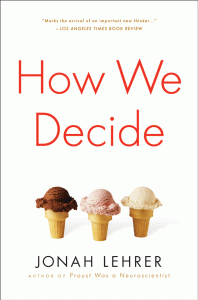Pedir demissão? Terminar um relacionamento? Flocos ou creme? Frear ou desviar? Sorrir? Demonstrar? Conceder ou exigir?
Decidimos o tempo todo. Nossas decisões guiam nossas atitudes. As atitudes formam nosso comportamento. Pequenas e grandes decisões acabam mostrando quem somos, ou gostaríamos de ser. E como acontece uma decisão? Como nosso cérebro pensa, raciocina, sente e conclui como uma decisão deve ser tomada? A ciência já sabe como interagem o córtex pré-frontal, as amídalas e outras partes do cérebro para chegar a uma conclusão?
 Aparentemente, é uma área científica em franca evolução, mas já é possível visualizar alguma lógica no processo de decisão. O livro How We Decide, de Jonah Lehrer, discute sobre como as áreas de nosso cérebro interagem para decidir. Jonah traz uma profunda discussão sobre as influências da razão, da emoção e a própria interação de uma com a outra. Há exemplos de decisões sob pressão, inconscientes, racionais, longas, instantâneas, geniais, certas e erradas.
Aparentemente, é uma área científica em franca evolução, mas já é possível visualizar alguma lógica no processo de decisão. O livro How We Decide, de Jonah Lehrer, discute sobre como as áreas de nosso cérebro interagem para decidir. Jonah traz uma profunda discussão sobre as influências da razão, da emoção e a própria interação de uma com a outra. Há exemplos de decisões sob pressão, inconscientes, racionais, longas, instantâneas, geniais, certas e erradas.
Esse foi o primeiro livro que li a fundo com o Kindle. Como o assunto me interessou muito, acabei relendo e destacando muitos trechos. Alguns deles, peço a licença de compartilhar com vocês e comentar. Naturalmente, nada substitui a leitura do livro, que recomendo. Mas, como a vida é um flash e não temos tempo para tudo, ficam aqui algumas observações.
“Desire and reason are pulling in different directions. I see the right way and approve it, but follow the wrong.”
Razão e emoção. Comer ou não aquela pizza e depois abiscoitar um petit gateau? Sabemos o caminho correto, mas quem nos faz seguir o errado?
Above that was the ego, which represented the conscious self and the rational brain. It was the job of the ego to restrain the id, channeling its animal emotions in socially acceptable ways.
Freud for dummies. Id são nossos instintos, emoções, desejos. O Ego é nossa razão, responsável por controlar o Id e filtrá-lo para comportamentos socialmente aceitáveis.
A brain that can’t feel can’t make up its mind.
Aqui já começa a parte mais técnica. A emoção é parte fundamental no processo de decisão. Sem emoção, não há decisão. O cérebro racional cria conjecturas, versões, alternativas. Mas é necessário que alguém dê a palavra definitiva. O córtex órbito-frontal é responsável por integrar emoções viscerais ao processo de decisão. Pessoas que tiveram problemas e perderam essa função cerebral não são capazes de tomar decisões. As emoções processam invisivelmente grandes porções de informação e ajudam o cérebro a assumir uma posição.
Este outro destaque já é de outra parte do livro, que fala sobre o processo de aprendizado e como nossos erros marcam de forma profunda nossas memórias. E isso acontece não só de formar racional, mas também irracionalmente. O erro é parte desejável e integrante do processo de aprender. Aqui, o livro de 2009 cita uma super tendência sobre educação infantil:
Unfortunately, children are often taught the exact opposite. Instead of praising kids for trying hard, teachers typically praise them for their innate intelligence (being smart). Dweck has shown that this type of encouragement actually backfires, since it leads students to see mistakes as signs of stupidity and not as the building blocks of knowledge. The regrettable outcome is that kids never learn how to learn.
Unless you experience the unpleasant symptoms of being wrong, your brain will never revise its models. Before your neurons can succeed, they must repeatedly fail. There are no shortcuts for this painstaking process.
Não tenhamos medo de errar.
Aqui tem outro trecho interessante. As partes do nosso cérebro se desenvolvem de maneira diferente, algumas mais rapidamente, outras menos. Nos adolescentes, essa teoria faz todo o sentido. Mentes que ainda não aprenderam a se controlar:
More than 50 percent of U.S. high school students have experimented with illicit drugs. Half of all reported cases of sexually transmitted diseases occur in teenagers. Car accidents are the leading cause of death for those under the age of twenty-one. These bleak statistics are symptoms of minds that can’t restrain themselves. While the emotional brains of teens are operating at full throttle (those raging hormones don’t help), the mental muscles that check these emotions are still being built.
Agora um clássico:
(He likes to quote Louis Pasteur: “Chance favors the prepared mind.”)
E agora um pouco sobre decisões que devem ser tomadas exclusivamente pela emoção:
There is such a thing as too much analysis. When you overthink at the wrong moment, you cut yourself off from the wisdom of your emotions, which are much better at assessing actual preferences.
Isso se refere a um trecho do livro que fala sobre testes cegos sobre alimentos. Vejamos um aqui. Alguns experts classificaram as melhores geleias dos EUA. Suponhamos que esta classificação esteja certa. Essas pessoas entendem de geleia e sabem julgar qual geleia é melhor. Agora, peguemos um grupo de leigos, uma amostra suficiente, e peçamos a eles que provem as geleias e as classifiquem de acordo com sua qualidade.
 O grupo de leigos chega a um resultado praticamente igual aos experts. Isso não é muita surpresa. Aparentemente, os experts estavam certos e os leigos conseguiram julgar bem.
O grupo de leigos chega a um resultado praticamente igual aos experts. Isso não é muita surpresa. Aparentemente, os experts estavam certos e os leigos conseguiram julgar bem.
Após esta primeira fase, faz-se um novo experimento de leigos, com outra amostra. A diferença é que, a este segundo grupo de leigos, é pedido que descrevam quais as características os fizeram decidir por uma ou outra geleia. Aqui, sim, o resultado surpreende. Os leigos se perderam completamente no julgamento. O resultado foi diferente dos dois testes anteriores e a classificação fez muito pouco sentido.
A conclusão direta aqui é que, para julgar geleias, é melhor confiar nas emoções do que no pensamento racional. Nosso cérebro racional se perde quando há muita informação para julgar. A não ser que tenhamos muita experiência no ramo em que estamos decidindo, acabamos enganados pelo excesso de informação:
It’s long been recognized that the placebo effect is extremely powerful; anywhere between 35 and 75 percent of people get better after receiving pretend medical treatments, such as sugar pills.
(…)
According to Shiv, consumers typically suffer from a version of the placebo effect. Since they expect cheaper goods to be less effective, they generally are less effective, even if the goods are identical to more expensive products. This is why brand-name aspirin works better than generic aspirin and why Coke tastes better than cheaper colas, even if most consumers can’t tell the difference in blind taste tests.
(…)
For example, when Thaler asked people whether they would drive twenty minutes out of their way to save five dollars on a fifteen-dollar calculator, 68 percent of respondents said yes. However, when he asked people whether they would drive twenty minutes out of their way to save five dollars on a $125 leather jacket, only 29 percent said they would.
(…)
The fragility of the prefrontal cortex means that we all have to be extremely vigilant about not paying attention to unnecessary information. The anchoring effect demonstrates how a single additional fact can systematically distort the reasoning process. Instead of focusing on the important variable—how much is that cordless keyboard really worth?—we get distracted by some meaningless numbers. And then we spend too much money.
(…)
(Herbert Simon said it best: “A wealth of information creates a poverty of attention.”)
Acho que uma lição aprendida aqui é analisar decisões que não devem lhe tomar tempo. Decidir de pronto não é necessariamente ruim. Não tentemos buscar variáveis obscuras onde não há.
Agora uma curiosidade para os colegas condor:
BACK PAIN IS a medical epidemic. The numbers are sobering: there’s a 70 percent chance that at some point in your life, you’ll suffer from it. There’s a 30 percent chance that you’ve suffered from severe back pain in the last thirty days. At any given time, about 1 percent of working-age Americans are completely incapacitated by their lower lumbar regions.
Adiante, falamos um pouco sobre a evolução da mente humana, no que diz respeito às emoções e a moral.
While psychopaths are prone to violence—especially when the violence is used to achieve a goal, like satisfying a sexual desire—their neurological condition is best defined in terms of a specific brain malfunction: psychopaths make poor—sometimes disastrous—moral choices.
(…)
Psychopaths shed light on a crucial subset of decision-making that’s referred to as morality. Morality can be a squishy, vague concept, and yet, at its simplest level, it’s nothing but a series of choices about how we treat other people. When you act in a moral manner—when you recoil from violence, treat others fairly, and help strangers in need—you are making decisions that take people besides yourself into account. You are thinking about the feelings of others, sympathizing with their states of mind. This is what psychopaths can’t do.
(…)
The evolution of morality required a whole new set of decision-making machinery. The mind needed to evolve some structures that would keep it from hurting other people. Instead of just seeking more pleasure, the brain had to become sensitive to the pain and plight of strangers. The new neural structures that developed are a very recent biological adaptation. While people have the same reward pathway as rats—every mammal relies on the dopamine system—moral circuits can be found in only the most social primates. Humans, of course, are the most social primates of all.
(…)
We aren’t angels, but we also aren’t depraved hominids. “Our primate ancestors,” Greene explains, “had intensely social lives. They evolved mental mechanisms to keep them from doing all the nasty things they might otherwise be interested in doing. This basic primate morality doesn’t understand things like tax evasion, but it does understand things like pushing your buddy off of a cliff.”
(…)
During World War II, for example, U.S. Army Brigadier General S.L.A. Marshall undertook a survey of thousands of American troops right after they’d been in combat. His shocking conclusion was that less than 20 percent actually shot at the enemy, even when under attack. “It is fear of killing,” Marshall wrote, “rather than fear of being killed, that is the most common cause of battle failure in the individual.” When soldiers were forced to confront the possibility of directly harming other human beings—this is a personal moral decision—they were literally incapacitated by their emotions.
Aparentemente, fomos evoluídos para fazer decisões moralmente boas. Não é algo que é desenvolvido pelo convívio social, é algo que nasce conosco. Há certas ações que nossos cérebros julgam como simplesmente ruins. E isso parece ter a ver com uma característica exclusiva dos humanos (e primatas desenvolvidos): a empatia. Empatia é a capacidade de imaginar o que o outro sente. Aos humanos “normais”, faz mal fazer o mal. E isso parece se dever ao fato de que nos colocamos no lugar do próximo.
Human minds are so eager to detect other minds that they often imbue inanimate objects, like computers and stuffed animals, with internal mental states.)
(…)
But here’s the lovely secret of altruism: it feels good. The brain is designed so that acts of charity are pleasurable; being nice to others makes us feel nice.
Um pouco a frente, lemos sobre os contornos que nosso cérebro racional faz para não admitir que está errado. Enxerguei-me muito nesse tópico. Digamos que você tem uma posição política e alguém cita algo errado que um membro de seu partido cometeu. Já aconteceu com você? Mesmo consigo mesmo, tenho certeza que sua mente deu muitas voltas até encontrar uma justificativa plausível para salvar sua posição. Veja esse estudo:
During the first term of Bill Clinton’s presidency, the budget deficit declined by more than 90 percent. However, when Republican voters were asked in 1996 what happened to the deficit under Clinton, more than 55 percent said that it had increased. What’s interesting about this data is that so-called high-information voters—these are the Republicans who read the newspaper, watch cable news, and can identify their representatives in Congress—weren’t better informed than low-information voters.
“Voters think that they’re thinking,” Bartels says, “but what they’re really doing is inventing facts or ignoring facts so that they can rationalize decisions they’ve already made.” Once you identify with a political party, the world is edited to fit with your ideology.
Nesse ponto, o livro fala sobre analistas políticos americanos. São pessoas que explicam de maneira racional situações altamente complexas envolvendo países, culturas, conflitos e centenas de outras variáveis. Nos anos 80, foi feito um estudo sobre temas diversos de geopolítica, coletando a opinião de analistas renomados. Depois de dez anos, percebeu-se que os analistas tinham um resultado pior do que o acaso. Isso mesmo. As perguntas normalmente tinham três respostas e o índice de acerto dos analistas foi de menos de 33%:
When pundits were convinced that they were right, they ignored any brain areas that implied they might be wrong. This suggests that one of the best ways to distinguish genuine from phony expertise is to look at how a person responds to dissonant data. Does he or she reject the data out of hand? Perform elaborate mental gymnastics to avoid admitting error?
(…)
In other words, ignore those commentators that seem too confident or self-assured. The people on television who are most certain are almost certainly going to be wrong.
(…)
It feels good to be certain. Confidence is comforting. This desire to always be right is a dangerous side effect of having so many competing brain regions inside one’s head. While neural pluralism is a crucial virtue—the human mind can analyze any problem from a variety of different angles—it also makes us insecure. You never know which brain area you should obey. It’s not easy to make up your mind when your mind consists of so many competing parts.
Aqui uma citação ótima, dá pra fazer uma camiseta:
The default state of the brain is indecisive disagreement;
O livro tira poucas conclusões. A seguir, uma delas.
The only way to counteract the bias for certainty is to encourage some inner dissonance. We must force ourselves to think about the information we don’t want to think about, to pay attention to the data that disturbs our entrenched beliefs.
(…)
The same lesson can be applied to the brain: when making decisions, actively resist the urge to suppress the argument. Instead, take the time to listen to what all the different brain areas have to say.
Para evitar que nosso rumo de pensamento fique viciado, temos que dar lugar à dissonância. É preciso flertar com a ideia contrária.
Já nas conclusões, saem algumas dicas de como se preparar para tomar as melhores decisões. Ou pelo menos para não ser enganado por si próprio:
“Use your conscious mind to acquire all the information you need for making a decision. But don’t try to analyze the information with your conscious mind. Instead, go on holiday while your unconscious mind digests it. Whatever your intuition then tells you is almost certainly going to be the best choice.”
(…)
As long as someone has sufficient experience in that domain—he’s taken the time to train his dopamine neurons—then he shouldn’t spend too much time consciously contemplating the alternatives.
(…)
If the emotional brain is a fancy laptop, stuffed full of microprocessors operating in parallel, the rational brain is an old-fashioned calculator.
 Essa última frase é bem emblemática do livro. Embora nosso cérebro racional seja bastante flexível, ele não é capaz de processar decisões com muitas variáveis. Somos limitados. Por outro lado, nossas emoções contêm um emaranhado de conhecimento enorme e têm poder para processá-lo, mesmo de que forma incompreensível.
Essa última frase é bem emblemática do livro. Embora nosso cérebro racional seja bastante flexível, ele não é capaz de processar decisões com muitas variáveis. Somos limitados. Por outro lado, nossas emoções contêm um emaranhado de conhecimento enorme e têm poder para processá-lo, mesmo de que forma incompreensível.
Bem, esta foi uma leitura disjunta e superficial de uma obra complexa e muito coerente. Espero que tenha servido para algo. No mínimo, para instigar a curiosidade. No meu caso, além de todo o conhecimento a que fui exposto, é sempre bom saber que há gente genial estudando de maneira séria assuntos avançados, misteriosos e dogmáticos como a mente humana.
